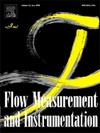用光通道体流传感器测量两相流中的气体流速。单通道原型的设计和验证
IF 2.3
3区 工程技术
Q2 ENGINEERING, MECHANICAL
引用次数: 0
摘要
气液两相流中气含率和流速的精确测量仍然是一个复杂而未解决的挑战。本文介绍了一种用于同时测量体积气体和液体流速的光通道体流传感器(OCBFS)的研制和评价。测量原理是基于在小毛细管中形成的段塞流状态,其中液相和气相分离。该传感器采用基于塑料光纤的传感原理。在液体速度为vl,s = 0.14-0.31 m/s,气体速度为vg,s = 0.015-0.95 m/s的单通道上,在直径为Dc = 2.5 mm的毛细管中形成段塞流,实验验证了该传感器在绝热条件下测量气体流量的准确性和可靠性,段塞流结果与参考值的偏差小于10%。OCBFS原型为两相系统的精确流量测量提供了坚实的基础,为需要可靠流量监测的应用推进了气液流量测量技术。本文章由计算机程序翻译,如有差异,请以英文原文为准。
Gas flow rate measurement in two-phase flows using an optical channel body flow sensor. Design and validation of the single-channel prototype
Accurate measurement of gas holdup and flow rates in gas-liquid two-phase flows remains a complex and unresolved challenge. This paper presents the development and evaluation of an Optical Channel Body Flow Sensor (OCBFS) designed for the simultaneous measurement of volumetric gas and liquid flow rates. The measurement principle is based on formation of slug flow regime in small capillaries, where liquid and gas phase are separated. The sensor utilizes a plastic optical fiber-based sensing principle. Experimental validation of the OCBFS was conducted for a single channel across a range of superficial velocities, with liquid velocities between vl,s = 0.14–0.31 m/s and gas velocities between vg,s = 0.015–0.95 m/s, resulting in the formation of slug flow in a capillary with a diameter Dc = 2.5 mm.
The slug flow results showed deviations of less than 10 % from reference values, confirming the sensor's accuracy and reliability in gas flow measurements under adiabatic conditions. The OCBFS prototype provides a solid foundation for precise flow measurement in two-phase systems, advancing gas-liquid flow measurement technologies for applications that require reliable flow rate monitoring.
求助全文
通过发布文献求助,成功后即可免费获取论文全文。
去求助
来源期刊

Flow Measurement and Instrumentation
工程技术-工程:机械
CiteScore
4.30
自引率
13.60%
发文量
123
审稿时长
6 months
期刊介绍:
Flow Measurement and Instrumentation is dedicated to disseminating the latest research results on all aspects of flow measurement, in both closed conduits and open channels. The design of flow measurement systems involves a wide variety of multidisciplinary activities including modelling the flow sensor, the fluid flow and the sensor/fluid interactions through the use of computation techniques; the development of advanced transducer systems and their associated signal processing and the laboratory and field assessment of the overall system under ideal and disturbed conditions.
FMI is the essential forum for critical information exchange, and contributions are particularly encouraged in the following areas of interest:
Modelling: the application of mathematical and computational modelling to the interaction of fluid dynamics with flowmeters, including flowmeter behaviour, improved flowmeter design and installation problems. Application of CAD/CAE techniques to flowmeter modelling are eligible.
Design and development: the detailed design of the flowmeter head and/or signal processing aspects of novel flowmeters. Emphasis is given to papers identifying new sensor configurations, multisensor flow measurement systems, non-intrusive flow metering techniques and the application of microelectronic techniques in smart or intelligent systems.
Calibration techniques: including descriptions of new or existing calibration facilities and techniques, calibration data from different flowmeter types, and calibration intercomparison data from different laboratories.
Installation effect data: dealing with the effects of non-ideal flow conditions on flowmeters. Papers combining a theoretical understanding of flowmeter behaviour with experimental work are particularly welcome.
 求助内容:
求助内容: 应助结果提醒方式:
应助结果提醒方式:


